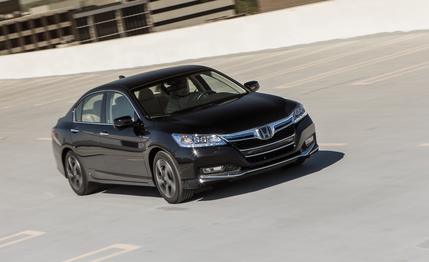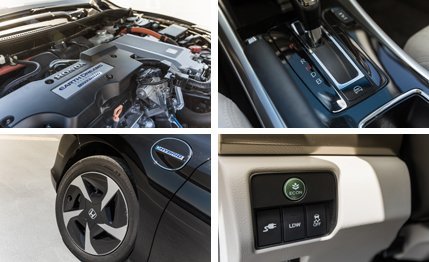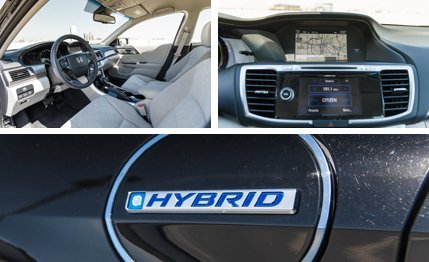 Instrumented Test
TESTED
Instrumented Test
TESTED
Two Accord generations ago, Honda offered a hybrid powertrain in its mainstream sedan. But it was a performance-oriented V-6 hybrid that never achieved the lofty fuel-economy numbers that eco buyers crave. Now, Honda is jumping back into the game with a new, efficiency-oriented Accord hybrid, and its mileage is impressive. It’s rated by the EPA at 47 in the city and 46 on the highway. Moreover, it’s a plug-in hybrid, and when operating on electric power, it gets 124 mpge in the city and 105 on the highway. Its combined rating of 115 mpge is bested only by Honda’s much smaller Fit EV.
To achieve this efficiency, the Accord plug-in uses an Earth Dreams 2.0-liter four-cylinder engine—this translates to a hybrid-typical Atkinson-cycle engine—coupled to a pair of electric motors, powered by a 6.7-kWh lithium-ion battery. The coupling arrangement is not the Integrated Motor Assist that Honda uses on other hybrids. Instead, it’s more like the Toyota and Ford systems, with a 166-hp AC traction motor and a smaller motor generator connected in such a way that the electric and gasoline power can be seamlessly blended.
The Accord system is smooth, efficient, and reasonably peppy, accelerating to 60 mph in 7.7 seconds and covering the quarter-mile in 16.1 seconds at 88 mph. That makes the Accord the quickest PHEV on the market, now that the Fisker Karma has bitten the dust.
With a fully charged battery, the Accord’s electric range is rated by the EPA at 13 miles. We measured 13.7 during an urban/suburban drive at the speed limit plus 5 mph. In the process, the Accord used 3.6 kWh of electricity, equivalent to 3.85 miles per kWh, an excellent figure. After the gas engine cut in, we averaged 42 mpg on a 500-mile drive from Ann Arbor to Michigan’s west coast and back.

This efficiency doesn’t come solely from the powertrain. The Accord plug-in gets low-rolling-resistance tires, a number of aerodynamic tweaks, and an aluminum hood, front subframe, and rear bumper beam to save a few pounds. Even so, the plug-in weighs 400 more pounds than a similarly equipped EX-L model.
That additional weight is not terribly obvious, as the plug-in uses the torque of its electric motor to move away briskly from a stop. Honda has recalibrated the power steering to help the car feel lighter. Unfortunately, its heft is now too light, to the detriment of on-center feel and general cornering feedback. Grip is also down, to 0.82 g, from the 0.86 g of the last conventional Accord we tested, and the suspension feels softer. It rides placidly on smooth pavement, but there’s too much body motion if you start pressing a bit harder on bumpy roads.
The new electric-servo brake, however, does a better job of blending regenerative braking with friction braking than that of most other electric-car brakes. The transmission offers a B (battery) mode that substantially increases regen when you release the accelerator. In the city, it lets you drive with one pedal most of the time, just like a Tesla does, and offers the same kind of lift-pedal deceleration you’d experience in first or second gear in a manual-transmission car.
Another feature that’s new to the Accord is the LaneWatch blind-spot display that turns on a camera in the right-side mirror whenever you activate your right turn signal. It brings up a view to the right, including your blind spot, in the main LCD in the center of the dash.

Inside, the plug-in is much like other Accords, with a good driving position, a logical control layout, and plenty of room. The new, Bio-Fabric upholstery looks and feels cheap, even if it’s produced by an environmentally friendly manufacturing process. And the Accord’s trunk gives up nearly half its (previously capacious) volume to the big battery. Outside, the plug-in is recognizable by its rear spoiler, several odd-looking bits of blue-toned brightwork, and tacky-looking aerodynamic wheels that might as well have been ripped from the shelves of Pep Boys.
Of course, the prime directive of hybrids is to deliver fuel efficiency, and this Accord does that in spades. Although we might like a bit more than 13 miles of electric range, the plug-in recharges quickly, needing only three hours on a standard 120-volt outlet and less than an hour with Honda’s 220-volt charger.
All this technical excellence costs a pretty penny—4,057,000 of them—although you do get a federal tax rebate of $3636, which brings the price down to $36,934. Compared with a well-equipped conventional Accord, which costs about six grand less, if you drive 10,000 miles in 20-mile chunks, with a full charge between each one, the plug-in will save you about $750. At that rate, you’ll break even after 80,000 miles. That rate of payback will have to improve before the plug-in becomes as mainstream as the rest of its Accord siblings.